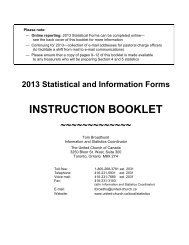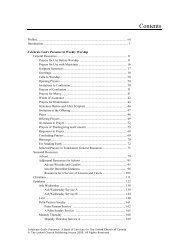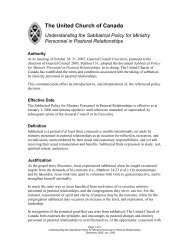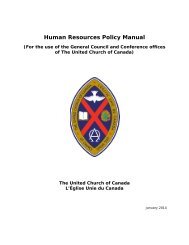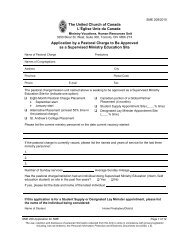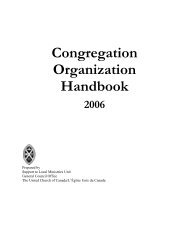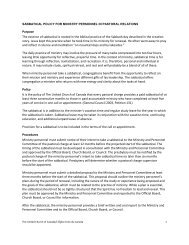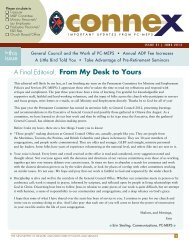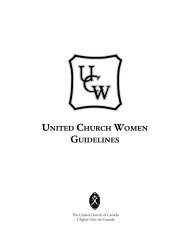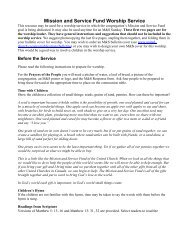Guidelines for Transition Teams - The United Church of Canada
Guidelines for Transition Teams - The United Church of Canada
Guidelines for Transition Teams - The United Church of Canada
You also want an ePaper? Increase the reach of your titles
YUMPU automatically turns print PDFs into web optimized ePapers that Google loves.
Appendix 11: Soliciting In<strong>for</strong>mation and Feedback<br />
At various times, the <strong>Transition</strong> Team will need to gather in<strong>for</strong>mation or feedback from the<br />
congregation. A number <strong>of</strong> methods may be used: planned but casual conversations; write-in<br />
comments; paper and pencil surveys; one-to-one interviews; group interviews; congregational<br />
meetings; post-meeting feedback <strong>for</strong>ms.<br />
Be<strong>for</strong>e choosing a method, consider these questions:<br />
• What type <strong>of</strong> in<strong>for</strong>mation is desired? Is it reaction to some issue? Establishing priorities? Phrase<br />
the question so as to get the kind <strong>of</strong> answer you are looking <strong>for</strong>.<br />
• Choose the method <strong>of</strong> getting feedback according to the in<strong>for</strong>mation sought and the part <strong>of</strong> the<br />
congregation to be heard from.<br />
• Who is likely to participate? (Bear in mind that a total response is not likely.)<br />
• Will the responses be representative or reflect a certain viewpoint? Will that be satisfactory?<br />
(Be realistic: e.g., a visioning response may be unlikely if there is a pervasive mood <strong>of</strong> gloom.)<br />
• Are the people you are asking in<strong>for</strong>med enough to be able to respond knowledgeably to the<br />
questions?<br />
Each method has advantages and disadvantages, and will provide different kinds <strong>of</strong> in<strong>for</strong>mation.<br />
Understand that the way questions are asked to a large extent determines whether responses will<br />
provide in<strong>for</strong>mation that is specific, relevant, and usable. Test the questions with each other to be<br />
sure you are asking in a way that elicits a useful response.<br />
Tips<br />
• Explain the purposes <strong>for</strong> collecting the in<strong>for</strong>mation.<br />
• Explain how the results will be used, and who will be seeing individual responses.<br />
• Make it easy <strong>for</strong> people to give the in<strong>for</strong>mation in as concise a way as possible.<br />
• Plan <strong>for</strong> how the in<strong>for</strong>mation will be collated; it may influence the way the questions are asked.<br />
• To test general reactions, use a rating scale (e.g., 1 to 5) rather than a yes/no choice.<br />
• On a paper response <strong>for</strong>m, always ask <strong>for</strong> “other” comments. (<strong>The</strong>se can sometimes produce gems!)<br />
• Respect confidentiality. Never divulge names unless permission is asked <strong>for</strong> and given.<br />
• If the resulting in<strong>for</strong>mation is returned to the congregation, do it in such a way that people may<br />
recognize their own contribution yet remain anonymous.<br />
<strong>Guidelines</strong> <strong>for</strong> <strong>Transition</strong> <strong>Teams</strong> 55



